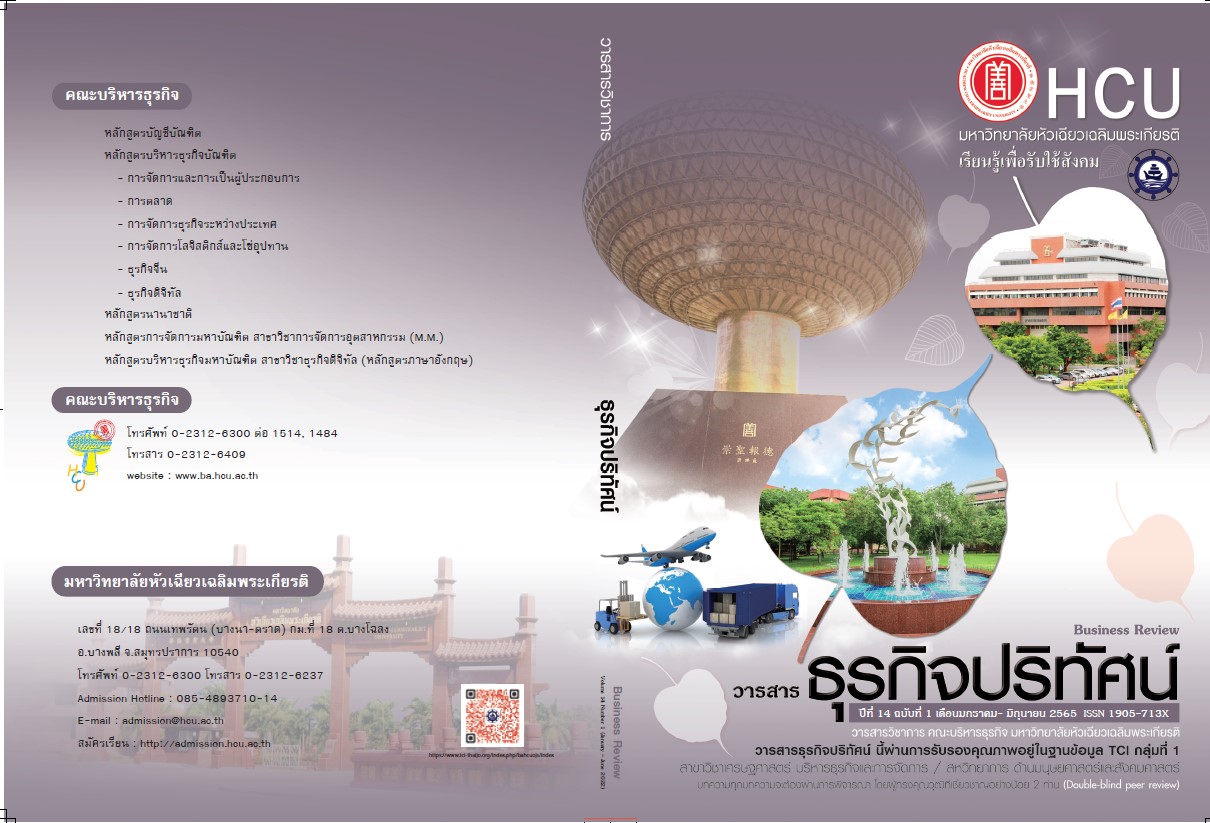อิทธิพลของจิตวิญญาณในสถานที่ทำงาน ค่านิยมในการทำงาน และความผูกพันต่อองค์การ ที่มีต่อพฤติกรรมการเป็นสมาชิกที่ดีขององค์การของพนักงานระดับปฏิบัติการ บริษัทผลิตท่อเหล็กเหนียวแห่งหนึ่ง
关键词:
จิตวิญญาณในสถานที่ทำงาน, ค่านิยมในการทำงาน, ความผูกพันต่อองค์การ, พฤติกรรมการเป็นสมาชิกที่ดีขององค์การ摘要
การวิจัยนี้มีวัตถุประสงค์เพื่อศึกษาอิทธิพลของจิตวิญญาณในสถานที่ทำงาน ค่านิยมในการทำงาน และความผูกพันต่อองค์การที่มีต่อพฤติกรรมการเป็นสมาชิกที่ดีขององค์การของพนักงานระดับปฏิบัติการบริษัทผลิตท่อเหล็กเหนียวแห่งหนึ่ง โดยเป็นการวิจัยด้วยวิธีผสมผสานระหว่างวิธีการเชิงปริมาณและเชิงคุณภาพ การวิจัยเชิงปริมาณเก็บรวบรวมข้อมูลจากกลุ่มตัวอย่าง จำนวน 185 คน เครื่องมือที่ใช้ในการวิจัยคือ แบบวัดจิตวิญญาณ ในสถานที่ทำงาน แบบวัดค่านิยมในการทำงาน แบบวัดความผูกพันต่อองค์การ และแบบวัดพฤติกรรมการเป็นสมาชิกที่ดีขององค์การ และสถิติที่ใช้ในการวิเคราะห์ข้อมูล ได้แก่ ค่าร้อยละ ค่าเฉลี่ย ค่าส่วนเบี่ยงเบนมาตรฐาน และการวิเคราะห์การถดถอยพหุแบบขั้นตอน การวิจัยเชิงคุณภาพใช้การสัมภาษณ์แบบเจาะลึกกับพนักงานกลุ่มตัวอย่าง จำนวน 6 คน เพื่ออธิบายผลการวิจัยเชิงปริมาณ ผลการวิจัยพบว่าค่านิยมในการทำงานด้านการกระตุ้น ให้ใช้ปัญญา ค่านิยมในการทำงานด้านการทำงานหลายๆ ด้าน ค่านิยมในการทำงานด้านความสุนทรีย์ จิตวิญญาณในสถานที่ทำงานด้านจิตสำนึกของเป้าหมายที่เข้มแข็ง และความผูกพันต่อองค์การด้านอารมณ์ สามารถร่วมกันพยากรณ์พฤติกรรมการเป็นสมาชิกที่ดีขององค์การของพนักงานระดับปฏิบัติการ บริษัทผลิตท่อเหล็กเหนียวแห่งหนึ่งได้ร้อยละ 51.8 (R2adj = .518) อย่างมีนัยสำคัญทางสถิติที่ระดับ .001 (p = .000)
参考
ชนิกานต์ เสียงเย็น. (2557). ภาวะผู้นำแบบผู้รับใช้ ความพึงพอใจในงาน จิตวิญญาณในการทำงานและพฤติกรรมการเป็นสมาชิกที่ดีขององค์การของหัวหน้างานในธุรกิจบัตรเครดิตและสินเชื่อ. ปริญญานิพนธ์วิทยาศาสตรมหาบัณฑิต, มหาวิทยาลัยเกษตรศาสตร์.
ณัฏฐพันธ์ เขจรนันทน์. (2551). พฤติกรรมองค์การ. กรุงเทพมหานคร: ซีเอ็ดยูเคชั่น.
ธนากรณ์ ใจสมานมิตร. (2563). วิถีการทำงานร่วมกันอย่างมีสุนทรียภาพ. สืบค้นเมื่อ 29 กุมภาพันธ์ 2563, จาก Jobpub.com เว็บไซต์: https://www.jobpub.com/articles/showarticle.asp?id=2750
ธรรมรัตน์ อยู่พรต. (2556). ค่านิยมในการทำงานที่ส่งผลต่อพฤติกรรมการเป็นสมาชิกที่ดีขององค์การของเจนเนอเรชั่นต่างๆ. วารสารบริหารธุรกิจ, 36(138), 40-62.
บริษัท แปซิฟิกไพพ์ จำกัด (มหาชน). (2560). แบบแสดงรายการข้อมูลประจำปี 2559 (แบบ 56-1). สืบค้นเมื่อ 29 มีนาคม 2564, จาก บริษัท แปซิฟิกไพพ์ จำกัด (มหาชน) เว็บไซต์: https://www.pacificpipe.co.th/files/publications/59-3[th].pdf
มณฑล สรไกรกิติกูล และสุนันทา เสียงไทย. (2556). มิติทางจิตวิญญาณในการทำงาน (Workplace Spirituality): ความท้าทายในการบริหารทรัพยากรมนุษย์. วารสาร มฉก.วิชาการ, 16(32), 129-140.
มนัชยา จันทเขต. (2551). ค่านิยมในการทำงาน ความผูกพันต่อองค์การ ความเชื่ออำนาจในตน กับพฤติกรรมการเป็นสมาชิกที่ดีขององค์การของพนักงานการไฟฟ้าส่วนภูมิภาค (สำนักงานใหญ่). ปริญญานิพนธ์ วิทยาศาสตรมหาบัณฑิต, มหาวิทยาลัยเกษตรศาสตร์.
ลักษ์พนมวรรณ บูรพา. (2557). พฤติกรรมการเป็นสมาชิกที่ดีขององค์กรของพนักงานเจเนอเรชั่นวายในกลุ่มธุรกิจโทรคมนาคมในนครหลวงเวียงจันทน์ สาธารณรัฐประชาธิปไตยประชาชนลาว. ปริญญานิพนธ์บริหารธุรกิจมหาบัณฑิต, มหาวิทยาลัยนเรศวร.
วิภาส ทองสุทธิ์. (2552). พฤติกรรมองค์การ. กรุงเทพมหานคร: อินทภาษ.
ศูนย์ข้อมูลเชิงลึกอุตสาหกรรมเหล็กไทย. (2563). รายชื่อผู้ประกอบการผลิตท่อเหล็กเหนียวในประเทศไทย. สืบค้นเมื่อ 6 กุมภาพันธ์ 2563, จาก ศูนย์ข้อมูลเชิงลึกอุตสาหกรรมเหล็กไทย เว็บไซต์: https://iiu.isit.or.th/th/directory/category.aspx?Group=1&Category=83
สไบทอง ชัยประภา. (2545). ค่านิยมในการทำงาน แรงจูงใจใฝ่สัมฤทธิ์ และพฤติกรรมการทำงานของหัวหน้างานในธุรกิจอุตสาหกรรมสิ่งทอที่เข้าร่วมโครงการพัฒนาผู้ประกอบการธุรกิจอุตสาหกรรมในเขตจังหวัดสมุทรสาคร. ปริญญานิพนธ์วิทยาศาสตรมหาบัณฑิต, มหาวิทยาลัยเกษตรศาสตร์.
สิริอร วิชชาวุธ. (2549). จิตวิทยาอุตสาหกรรมและองค์การเบื้องต้น. กรุงเทพมหานคร: มหาวิทยาลัยธรรมศาสตร์.
สุชาติ ประสิทธิ์รัฐสินธุ์. (2540). เทคนิคการวิเคราะห์ตัวแปรหลายตัวสำหรับการวิจัยทางสังคมศาสตร์และพฤติกรรม: หลักการวิธีการประยุกต์ (พิมพ์ครั้งที่ 4). กรุงเทพมหานคร: โรงพิมพ์เลี่ยงเชี่ยง.
สุพานี สฤษฎ์วานิช. (2552). พฤติกรรมองค์การสมัยใหม่ แนวคิดและทฤษฎี (พิมพ์ครั้งที่ 3). กรุงเทพมหานคร: โรงพิมพ์มหาวิทยาลัยธรรมศาสตร์.
Ababneh, K. I., & Hackett, R. D. (2018). The direct and indirect impacts of job characteristics on faculty organizational citizenship behavior in the United Arab Emirates (UAE). Higher Education, 77(2), 19-36.
Ahmadi, S., Nami, Y., & Barvarz R. (2014). The relationship between spirituality in the workplace and organizational citizenship behavior. Procedia - Social and Behavioral Sciences, 114, 262-264.
Allen, N. J., & Meyer, J. P. (1990). The measurement and antecedents of affective, continuance and normative commitment to the organization. Journal of Occupational Psychology, 63, 1-18.
Amah, O. E. (2017). Organizational citizenship behavior across cultures: are organizational citizenship behavior scales transferable across cultures?. Research Journal of Business Management, 11(2), 56-66.
Anvari, R., Barzaki, A. S.,Amiri, l.,Irum, S., & Shapourabadi, S. (2017). The mediating effect of organizational citizenship behavior on the relationship between workplace spirituality and intention to leave. Intangible Capital, 13(3), 615-639.
Arsenich, V. A. (2018). The relationship between workplace wpirituality and organizational citizenship behavior among receptionists (GPRs). Doctor of Philosophy Thesis, Capella University.
Cho, Y. B., & Ha, T. Y. (2016). A study on effect of workplace spirituality of community enterprise on organizational citizenship behavior: mediating effects of job satisfaction. Management and Information Systems Review, 35(2), 137-165.
Garcia-Zamor, J. (2003). Workplace spirituality and organizational performance. Public Administration Review, 63(3), 355-363.
Guven, B. (2018). The quantitative and qualitative analysis of organizational citizenship behavior. Journal of Business & Economic Policy, 5(3), 54-66.
Haghighi, F. B., & Maleki, Z. V. (2016). The relationship between transformational leadership style and behavior of organizational citizen (case study: Ghavamin Bank). International Journal of Learning and Development, 6(3), 80-91.
Ibrahim, M. A., & Aslinda, A. (2013). Relationship between organizational commitment and organizational citizenship behavior (OCB) at government-owned corporation companies. Journal of Public Administration and Governance, 3(3), 35-42.
Khaskheli, A., Jiang, Y., Raza,S. A., Qureshi, M. A., Khan, K. A., & Salam, J. (2020). Do CSR activities increase organizational citizenship behavior among employees? Mediating role of affective commitment and job satisfaction. Corporate Social Responsibility and Environmental Management, 27(6), 1-15.
Kim, Y. J., Hunsaker, W. D. (2018). The effect of workplace spirituality on organizational citizenship behavior: the mediating effect of job engagement. The International Journal of Humanities & Social Studies, 6(2), 67-74.
Kinjerski, V., & Skrypnek, B. J. (2006). A human ecological model of spirit at work. Journal of Management Spirituality & Religion, 3(3), 231-241.
Kumari, P., & Thapliyal, S. (2017). Studying the impact of organizational citizenship behavior on organizational effectiveness. Human Resource Management, 4(1), 9-21.
Lee, Y. H., Woo, B., & Kim, Y. (2017). Transformational leadership and organizational citizenship behavior: Mediating role of affective commitment. International Journal of Sports Science & Coaching, 0(0), 1-10.
Leephaijaroen, S. (2016). Effects of the big-five personality traits and organizational commitments on organizational citizenship behavior of support staff at Ubon Ratchathani Rajabhat University Thailand. Kasetsart Journal of Social Sciences, 37(2), 1-8.
Liang, Y. W. (2012). The relationships among work values, burnout, and organizational citizenship behaviors: a study from hotel front-line service employees in Taiwan. International Journal of Contemporary Hospitality Management, 24(2), 251-268.
Maric, M., Hernaus, T., Vujcic, M. T., & Cerne M. (2019). Job characteristics and organizational citizenship behavior: a multisource study on the role of work engagement. Drustvena Istrazivanja, 28(1), 25-45.
Mat Ali, N. A., Panatik, S. A., & Zainal Badri, S. K. (2020). Impact of work values in promoting organizational citizenship behavior among academicians: the mediating roles of job satisfaction. Social Sciences & Humanities, 28(1), 617-632.
Meyer, J. P., & Allen, N. J. (1991). A three-component conceptualization of organizational commitment. Human Resource Management Review, 1(1), 61-89.
Mohd Yusoff, M. A., Abdul Razak, M. R., Abu Said, A. M., Mohd Noor, M. N., & Yusof, A. (2017).
Organizational citizenship behavior in manufacturing organizations: the influence of commitment, leadership, and teamwork on altruism. Science International (Lahore), 29(1), 315-319.
Nunnally, J. C., & Bernstein, I. H. (1994). Psychometric theory (3rd ed.). New York: McGraw-Hill.
Ojebola, O. O., Osibanjo, A. O., Adeniji, A. A., Salau, O. P., & Falola, H. O. (2020). Organizational citizenship behavior and its influence on manufacturing firms survival in Nigeria: a systematic review. Academy of Strategic Management Journal, 19(1), 1-14.
Organ, D. W. (1997). Organizational citizenship behavior: it's construct clean-up time. Human Performance, 10(2), 85-97.
Organ, D. W., & Bateman, T. S. (1991). Organizational Behavior (4th ed.). Boston: Irwin.
Robbins, S. P., & Judge, T. A. (2007). Organizational Behavior (12nd ed.). New Jersey: Pearson Education.
_______. (2013). Organizational Behavior (15th ed.). New Jersey: Pearson Education.
_______. (2017). Organizational Behavior (17th ed.). Essex: Pearson Education.
Sastrawijaya, A., Retnowati, R., Hardhienata, S., & Arifin, M. Z. (2019). Sequential exploratory organization analysis citizenship behavior, PAUD teacher in Cirebon City. Opcion, 35(22), 2899-2921.
Srour, C. K., Kheir-El-Din, A., & Samir, Y. M. (2020). The effect of green transformational leadership on organizational citizenship behavior in Egypt. Academic Journal of Interdisciplinary Studies, 9(5), 1-16.
Steers, R. M. (1977). Antecedents and outcomes of organizational commitment. Administrative Science Quarterly, 22(1), 46-56.
Tharikh, S. M., Ying, C. Y., Saad, Z. M., & Sukumaran, K. (2016). Managing job attitudes: the roles of job satisfaction and organizational commitment on organizational citizenship behaviors. Procedia Economics and Finance, 35, 604-611.
Zytowski, D. G. (1994). A super contribution to vocational theory: work values. The Career Development Quartery, 43(1), 25-31.
##submission.downloads##
已出版
##submission.howToCite##
期
栏目
##submission.license##
##submission.copyrightStatement##
##submission.license.cc.by-nc-nd4.footer##บทความที่ได้รับการตีพิมพ์เป็นลิขสิทธิ์ของวารสารธุรกิจปริทัศน์
ข้อความที่ปรากฏในบทความแต่ละเรื่องในวารสารวิชาการเล่มนี้เป็นความคิดเห็นส่วนตัวของผู้เขียนแต่ละท่านไม่เกี่ยวข้องกับมหาวิทยาลัยหัวเฉียวเฉลิมพระเกียรติ และคณาจารย์ท่านอื่น ๆ ในมหาวิทยาลัยฯ แต่อย่างใด ความรับผิดชอบองค์ประกอบทั้งหมดของบทความแต่ละเรื่องเป็นของผู้เขียนแต่ละท่าน หากมีความผิดพลาดใดๆ ผู้เขียนแต่ละท่านจะรับผิดชอบบทความของตนเองแต่ผู้เดียว




